Information
125 Tombs of Han Dynasty found in Tushantun Cemetery in Shandong Province
Summary: From May 2016 to December 2017, Qingdao Municipal Institute of Cultural Relics and Archaeology cooperated with Huangdao District Museum excavated part of Tushantun Cemetery in Huangdao District Qingdao City, Shandong Province and made significant finds. A
From May 2016 to December 2017, Qingdao Municipal Institute of Cultural Relics and Archaeology cooperated with Huangdao District Museum excavated part of Tushantun Cemetery in Huangdao District Qingdao City, Shandong Province and made significant finds. Altogether 178 tombs were cleared this time, among which 25 were of East Zhou Dynasty, 125 were of Han Dynasty, and 28 were of Qing Dynasty. The most significant were of Han Dynasty, unique in structure and with abundant well-preserved relics unearthed.
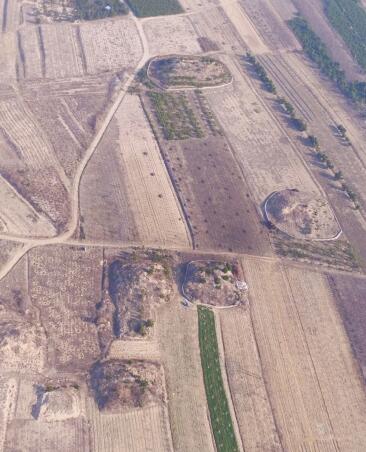
Aerial photo of Tushantun Cemetery before excavation
Remains and Assemblage
15 mounds of Han dynasty were found, and there were usually two tombs under one mound (four tombs beneath Mound 1). There was a time sequence between the tombs. Latter tomb was built on the former mound, upon which a new mound was built to make a larger mound on the whole. There were remains of ditches outside the tomb pit, which might be drainage or furrows. It was the first brick platform found in the excavation of Han cemetery. Altogether seven brick platforms were found to the south of the mound, which might be "sacrificial altar" according to preliminary speculation.
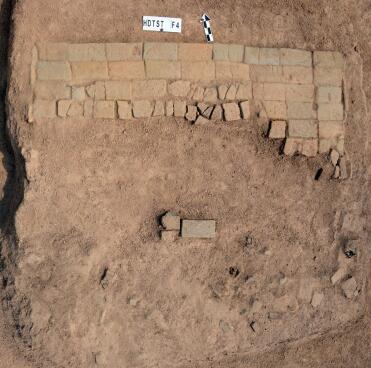
Ritual altar in front of the No.4 mound The major pattern of Han tomb was vertical rock pit tomb with brick-wood outer coffin. Part of the tombs had “甲" shaped tomb passage. The inner and outer coffins were of different types, such as double inner coffins with three outer coffins, double inner with double outer coffins, single inner coffin with double outer coffins, double inner coffins with single outer coffin, single inner with single outer coffin and so on. There were both brick outer coffin and wood outer coffin. Some well-preserved outer coffins were even found with logs paved on the top of it, which seemed to be imitating roof beams. Tomb M177 was in complex structure with pottery shards and tile fragments piled outside the outer coffin, namely "pottery stuffed tomb". Based on the unearthed written records of the tomb owner (seal and Qiance “list of burial objects”), we inferred these tombs as tomb ground for the Liu family.
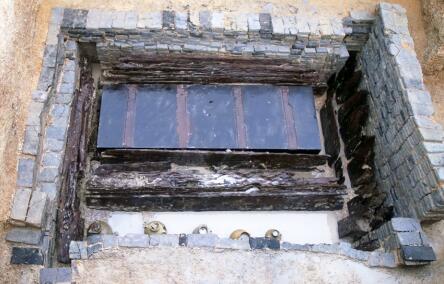
The inner and outer coffin of tomb M147
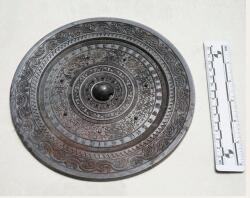
Bronze mirror unearthed from M170
There were altogether 1000 pieces (sets) grave goods unearthed during the archaeological excavation of Tushantun tombs, mainly pottery, Proto-celadon, bronze ware, iron ware, lacquer woodwork, jade and silk. The Proto-celadon were mostly pots and amphora made in Wu-Yue region. Bronze ware included mirrors, buckles, rings and seals, with mirror taking up the most substantial portion. The iron ware included sharpener and swords. The lacquer woodwork included lacquered case, board, plate, goblet, dressing case, wooden swords, pillow, tablet and inscribed bamboo slip. The jade included seal, buckle, jade mat, and jade Wenming (a kind of burial object). The jade seal with ink printing surface was unearthed from M147, supposed to be burial object. The Jade mat was found beneath the body of the owner of M147, a mat made of linked glazed sheets (lead-barium glass). Wenming was found in the north of the coffin in M147 over the head of the tomb owner. It was a Han Dynasty Wenming with the most complicated structure, most intricate skill and best preserving condition.

Orthoimage of the jade mat
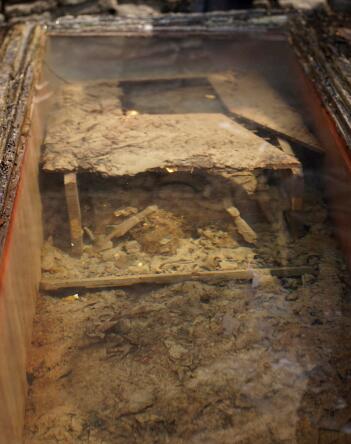
Jade Wenming (a kind of burial object)
Altogether 23 wooden tablets were found, 8 of which were Qiance “list of burial objects” and 6 were work statements. The record of "wenming”, “jade mat” and “account book of Tangyi County” on the catalogue unearthed from M147 was of special significance. The “work statement” wooden tablets recorded the city size, population, number of officials, criminals, troops, diseases and farming lands etc. of Tangyi County in the second year of Yuanshou reign (1 BC).
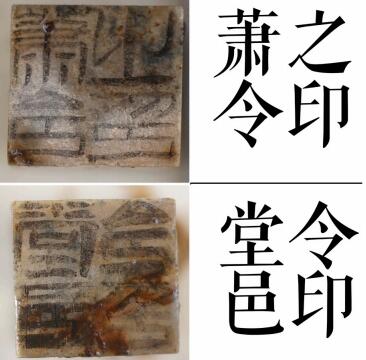
The jade seal from M147
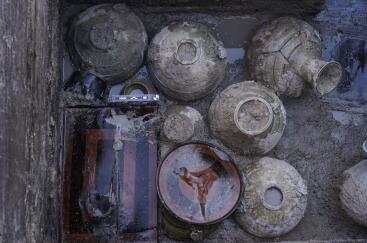
The head niche and proto-celadon in tomb M178
Academic significance
Tushantun cemetery was well preserved in layout, mould, sacrificial altar, coffin structure and burial objects. They formed complete organic system, a rarity in the excavation of middle class and lower aristocrat tombs in Han Dynasty. The tomb structure and unearthed objects bore evident features of Wu-Yue Culture, showing symbolic significance in the study of burial custom along the seaside of southeast Shandong Province as well as the economic and cultural communication between the south and the north regions. Precious burial objects like unearthed documents provided valuable data for the study of the political system, regional culture as well as material and culture communication in Han Dynasty. (Translator: Yuan Yuan)

Aerial photo of Tushantun Cemetery before excavation
Remains and Assemblage
15 mounds of Han dynasty were found, and there were usually two tombs under one mound (four tombs beneath Mound 1). There was a time sequence between the tombs. Latter tomb was built on the former mound, upon which a new mound was built to make a larger mound on the whole. There were remains of ditches outside the tomb pit, which might be drainage or furrows. It was the first brick platform found in the excavation of Han cemetery. Altogether seven brick platforms were found to the south of the mound, which might be "sacrificial altar" according to preliminary speculation.

Ritual altar in front of the No.4 mound

The inner and outer coffin of tomb M147

Bronze mirror unearthed from M170
There were altogether 1000 pieces (sets) grave goods unearthed during the archaeological excavation of Tushantun tombs, mainly pottery, Proto-celadon, bronze ware, iron ware, lacquer woodwork, jade and silk. The Proto-celadon were mostly pots and amphora made in Wu-Yue region. Bronze ware included mirrors, buckles, rings and seals, with mirror taking up the most substantial portion. The iron ware included sharpener and swords. The lacquer woodwork included lacquered case, board, plate, goblet, dressing case, wooden swords, pillow, tablet and inscribed bamboo slip. The jade included seal, buckle, jade mat, and jade Wenming (a kind of burial object). The jade seal with ink printing surface was unearthed from M147, supposed to be burial object. The Jade mat was found beneath the body of the owner of M147, a mat made of linked glazed sheets (lead-barium glass). Wenming was found in the north of the coffin in M147 over the head of the tomb owner. It was a Han Dynasty Wenming with the most complicated structure, most intricate skill and best preserving condition.

Orthoimage of the jade mat

Jade Wenming (a kind of burial object)

The jade seal from M147

The head niche and proto-celadon in tomb M178
Tushantun cemetery was well preserved in layout, mould, sacrificial altar, coffin structure and burial objects. They formed complete organic system, a rarity in the excavation of middle class and lower aristocrat tombs in Han Dynasty. The tomb structure and unearthed objects bore evident features of Wu-Yue Culture, showing symbolic significance in the study of burial custom along the seaside of southeast Shandong Province as well as the economic and cultural communication between the south and the north regions. Precious burial objects like unearthed documents provided valuable data for the study of the political system, regional culture as well as material and culture communication in Han Dynasty. (Translator: Yuan Yuan)
Category: English
News
Information
Key words:
